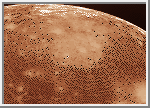 Callisto
Callisto Callisto
CallistoJupiter IV

Callisto [kah-LISS-toe] is the second largest moon of Jupiter. It has no atmosphere and is about the same size as Mercury. It is composed of approximately equal proportions of ice-water and rock. Its crust is very old and heavily cratered with remnant rings of enormous impact craters. The largest craters have been erased by the flow of the icy crust over geologic time. Craters and the associated concentric rings are about the only features to be found on Callisto.
The moon is probably composed of a large rocky core surrounded by water and ice, giving it a dark color. Meteorites have punctured holes in the crust, causing water to spread over the surface and forming bright rays and rings around the crater.

Discovered by ................ Simon Marius & Galileo Galilei Date of discovery ...................................... 1610 Mass (kg) .......................................... 1.08e+23 Mass (Earth = 1) ................................. 1.8072e-02 Equatorial radius (km) ................................ 2,400 Equatorial radius (Earth = 1) .................... 3.7629e-01 Mean density (gm/cm^3) ................................. 1.86 Mean distance from Jupiter (km) ................... 1,883,000 Rotational period (days) ........................... 16.68902 Orbital period (days) .............................. 16.68902 Mean orbital velocity (km/sec) ......................... 8.21 Orbital eccentricity .................................. 0.007 Orbital inclination ................................... 0.281° Escape Velocity (km/sec) ............................... 2.45 Visual geometric albedo ................................ 0.20 Magnitude (Vo) ......................................... 5.65

 Callisto
(GIF, 240K)
Callisto
(GIF, 240K)
This image shows the heavily cratered surface of Callisto. It was taken
by Voyager 2 on July 7, 1979.
An enormous impact basin with concentric rings is located near the top and
slightly left of center.
(Credit: Calvin J. Hamilton)
 High-Resolution Image of Callisto
(GIF, 2M)
High-Resolution Image of Callisto
(GIF, 2M)
This high-resolution image of Callisto shows its heavily cratered
surface. The impact basin, Valhalla, is located towards the bottom-left
of the image.
(Credit: Calvin J. Hamilton)
 Callisto's Valhalla Region
(GIF, 775K)
Callisto's Valhalla Region
(GIF, 775K)
This close up of Callisto shows the heavily cratered surface and
the prominent ring structure known as Valhalla. It was acquired by
Voyager 1 on March 6, 1979.
Valhalla's bright central area is about 300 kilometers across with sets
of concentric ridges extending out to 1,500 kilometers from the center.
(Credit: Calvin J. Hamilton)
 Gipul Catena
(GIF, 114K)
Gipul Catena
(GIF, 114K)
This image of an chain of craters on Callisto is 620 kilometers long.
The largest crater is 40 kilometers across. This is the longest of 12
or so such chains on Callisto. The chain probably formed from the
collision of a comet that was tidally disrupted during close
passage of Jupiter, such as the comet
Shoemaker-Levy 9.
(Credit: Calvin J. Hamilton)

